Brassica oleracea
| Brassica oleracea | |
|---|---|

| |
| Wild cabbage plants | |
| Scientific classification | |
| Kingdom: | Plantae |
| Clade: | Tracheophytes |
| Clade: | Angiosperms |
| Clade: | Eudicots |
| Clade: | Rosids |
| Order: | Brassicales |
| Family: | Brassicaceae |
| Genus: | Brassica |
| Species: | B. oleracea
|
| Binomial name | |
| Brassica oleracea | |
| Synonyms[2] | |
|
List
| |
Brassica oleracea is a plant of the family Brassicaceae, also known as wild cabbage in its uncultivated form. The species evidently originated from feral populations of related plants in the Eastern Mediterranean, where it was most likely first cultivated. It has many common cultivars used as vegetables, including cabbage, broccoli, cauliflower, kale, Brussels sprouts, collard greens, Savoy cabbage, kohlrabi, and gai lan.
Description
[edit]Wild B. oleracea is a tall biennial or perennial plant[3] that forms a stout rosette of large leaves in the first year. The grayish-green leaves are fleshy and thick,[4] helping the plant store water and nutrients in difficult environments. In its second year, a woody spike grows up to 1.5 metres (5 ft) tall, from which branch off stems with long clusters of yellow four-petaled flowers.[4]
Taxonomy
[edit]Origins
[edit]According to the Triangle of U theory, B. oleracea is very closely related to five other species of the genus Brassica.[5] A 2021 study suggests that Brassica cretica, native to the Eastern Mediterranean, particularly Greece and the Aegean Islands, was the closest living relative of cultivated B. oleracea, thus supporting the view that its cultivation originated in the Eastern Mediterranean region, with later admixture from other Brassica species.[6] Genetic analysis of nine wild populations on the French Atlantic coast indicated their common feral origin, deriving from domesticated plants escaped from fields and gardens.[7]
The cultivars of B. oleracea are grouped by developmental form into several major cultivar groups, of which the Acephala ("non-heading") group remains most like the natural wild cabbage in appearance.
Etymology
[edit]'Brassica' was Pliny the Elder's name for several cabbage-like plants.[8]
Its specific epithet oleracea means "vegetable/herbal" in Latin and is a form of holeraceus (oleraceus).[9][10]
Distribution and habitat
[edit]Although rarely abundant, wild cabbage is found on the coasts of Britain, France, Spain, and Italy.[4]
Wild cabbage is a hardy plant with high tolerance for salt and lime. Its intolerance of competition from other plants[11] typically restricts its natural occurrence to limestone sea cliffs, like the chalk cliffs on both sides of the English Channel.[12]
Cultivation
[edit]
B. oleracea has become established as an important human food crop plant, used because of its large food reserves, which are stored over the winter in its leaves. It has been bred into a wide range of cultivars, including cabbage, broccoli, cauliflower, brussels sprouts, collards, and kale, some of which are hardly recognizable as being members of the same genus, let alone species.[13] The historical genus of Crucifera, meaning "cross-bearing" in reference to the four-petaled flowers, may be the only unifying feature beyond taste.
Researchers believe it has been cultivated for several thousand years, but its history as a domesticated plant is not clear before Greek and Roman times, when it was a well-established garden vegetable. Theophrastus mentions three kinds of rhaphanos (ῤάφανος):[14] a curly-leaved, a smooth-leaved, and a wild-type.[15] He reports the antipathy of the cabbage and the grape vine, for the ancients believed cabbages grown near grapes would impart their flavour to the wine.[16]


History
[edit]Through artificial selection for various phenotype traits, the emergence of variations of the plant with drastic differences in appearance occurred over centuries. Preference for leaves, terminal buds, lateral buds, stems, and inflorescences resulted in selection of varieties of wild cabbage into the many forms known today. The wild plant (and its ancestors) originated in the eastern Mediterranean region of Europe. Estimated from Sanskrit writings 4,000 years ago, as well as Greek writings from the sixth century BC, plant cultivation may have occurred.[17]
Impact of preference
[edit]The preference for eating the leaves led to the selection of plants with larger leaves being harvested and their seeds planted for the next growth. Around the fifth century BC, the formation of what is now known as kale had developed.[18] Preference led to further artificial selection of kale plants with more tightly bunched leaves or terminal buds. Around the first century AD, the phenotype variation of B. oleracea known as cabbage emerged.[citation needed] Phenotype selection preferences in Germany resulted in a new variation from the kale cultivar. By selecting for wider stems, the variant plant known as kohlrabi emerged around the first century AD.[citation needed]
European preference emerged for eating immature buds, selecting for inflorescence. Early records in 15th century AD, indicate that early cauliflower and broccoli heading types were found throughout southern Italy and Sicily, although these types may not have been resolved into distinct cultivars until about 100 years later.[19][13][20][21] Further selection in Belgium in lateral bud led to Brussels sprouts in the 18th century.
Cultivar groups
[edit]According to the Royal Botanic Gardens (Kew Species Profiles)[22] the species has eight cultivar groups. Each cultivar group has many cultivars, like 'Lacinato' kale or 'Belstar' broccoli.
- Acephala: non-heading cultivars (kale, collards, ornamental cabbage, ornamental kale, flowering kale, tree cabbage).
- Alboglabra: Asian Cuisine cultivars (Chinese kale, Chinese broccoli, gai lan, kai lan).
- Botrytis: cultivars that form compact inflorescences (broccoli, cauliflower, broccoflower, calabrese broccoli, romanesco broccoli).[a]
- Capitata: cabbage and cabbage-like cultivars (cabbage, savoy cabbage, red cabbage).
- Gemmifera: bud-producing cultivars (sprouts, Brussels sprouts)
- Gongylodes: turnip-like cultivars (kohlrabi, knol-kohl)
- Italica: sprouts (purple sprouting broccoli, sprouting broccoli). Edible inflorescences not compacted into a single head.
- Tronchuda: low-growing annuals with spreading leaves (Portuguese cabbage, seakale cabbage).
A 2024 study compares 704 B. oleracea sequences and establishes a phylogenetic tree of cultivars. The authors find large-scale changes in gene expression and gene presence. Some genes are putatively linked to certain traits such as arrested inflorescence (typical of cauliflower and broccoli).[24]
| Cultivar | Image | Cultivar group (Kew) | Name (variety, form) |
|---|---|---|---|
| Wild cabbage | 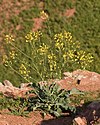
|
N/A | Brassica oleracea var. oleracea |
| Cabbage | 
|
Capitata | Brassica oleracea var. capitata f. alba |
| Savoy cabbage | 
|
Capitata | Brassica oleracea var. capitata f. sabauda |
| Red cabbage | 
|
Capitata | Brassica oleracea var. capitata f. rubra |
| Cone cabbage | 
|
Capitata | Brassica oleracea var. capitata f. acuta |
| Gai lan | 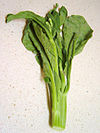
|
Alboglabra | Brassica oleracea var. alboglabra |
| Collard greens | 
|
Acephala | Brassica oleracea var. viridis |
| Jersey cabbage | 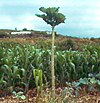
|
Acephala | Brassica oleracea var. longata |
| Ornamental kale | 
|
Acephala | Brassica oleracea var. acephala |
| Kale | 
|
Acephala | Brassica oleracea var. sabellica |
| Lacinato kale | 
|
Acephala | Brassica oleracea var. palmifolia |
| Perpetual kale | 
|
Acephala | Brassica oleracea var. ramosa |
| Kalette | 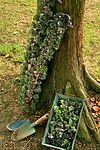
|
Hybrid | Brassica oleracea var. viridis x gemmifera |
| Marrow cabbage | 
|
Acephala | Brassica oleracea var. medullosa |
| Tronchuda kale | 
|
Tronchuda | Brassica oleracea var. costata |
| Brussels sprout | 
|
Gemmifera | Brassica oleracea var. gemmifera |
| Kohlrabi | 
|
Gongylodes | Brassica oleracea var. gongylodes |
| Broccoli | 
|
Botrytis[a] | Brassica oleracea var. italica |
| Cauliflower | 
|
Botrytis | Brassica oleracea var. botrytis |
| Caulini | 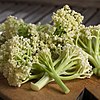
|
Botrytis | Brassica oleracea var. botrytis |
| Romanesco broccoli | 
|
Botrytis | Brassica oleracea var. botrytis |
| Broccoli di Torbole | 
|
Botrytis | Brassica oleracea var. botrytis |
| Broccoflower | 
|
Hybrid (within Botrytis) | Brassica oleracea var. botrytis × italica |
| Broccolini | 
|
Hybrid | Brassica oleracea var. italica × alboglabra |
Uses
[edit]Human genetics in relation to taste
[edit]The TAS2R38 gene encodes a G protein-coupled receptor that functions as a taste receptor, mediated by ligands such as propylthiouracil (PTU) and phenylthiocarbamide that bind to the receptor and initiate signaling that confers various degrees of taste perception. Vegetables in the brassica family, such as collard greens, kale, broccoli, cabbage, and Brussels sprouts, contain glucosinolates and isothiocyanates, which resemble PTU, and therefore much of the perceived "bitterness" of these vegetables is mediated through TAS2R38.[dubious – discuss] Bitter taste receptors in the TS2R family are also found in gut mucosal and pancreatic cells in humans and rodents. These receptors influence release of hormones involved in appetite regulation, such as peptide YY and glucagon-like peptide-1, and therefore may influence caloric intake and the development of obesity. Thus, bitter taste perception may affect dietary behaviors by influencing both taste preferences and metabolic hormonal regulation.[25]
Three variants in the TAS2R38 gene – rs713598, rs1726866, and rs10246939 – are in high linkage disequilibrium in most populations and result in amino acid coding changes that lead to a range of bitter taste perception phenotypes. The PAV haplotype is dominant; therefore, individuals with at least one copy of the PAV allele perceive molecules in vegetables that resemble PTU as tasting bitter, and consequently may develop an aversion to bitter vegetables. In contrast, individuals with two AVI haplotypes are bitter non-tasters. PAV and AVI haplotypes are the most common, though other haplotypes exist that confer intermediate bitter taste sensitivity (AAI, AAV, AVV, and PVI). This taste aversion may apply to vegetables in general.[25][26]
Notes
[edit]- ^ a b Technically, broccoli is an inflorescence, and so it belongs to the Botrytis group. However, because its subspecies name is Brassica oleracea var. italica, some many put it in the Italica group, including The North Carolina State University Cooperative Extension.[23]
References
[edit]- ^ Holubec, V., Uzundzhalieva, K., Vörösváry, G., Donnini, D., Bulińska, Z. & Strajeru, S. 2011. Brassica oleracea. The IUCN Red List of Threatened Species 2011: e.T170110A6717557. https://dx.doi.org/10.2305/IUCN.UK.2011-1.RLTS.T170110A6717557.en. Downloaded on 02 July 2021.
- ^ "Brassica oleracea L." Plants of the World Online. Board of Trustees of the Royal Botanic Gardens, Kew. 2017. Retrieved 27 August 2020.
- ^ "Brassica oleracea Wild Cabbage, Broccoli, Tronchuda cabbage, Brussels sprouts, Kohlrabi, Sprouting broccol". PFAF Plant Database. Retrieved 2024-12-26.
- ^ a b c Francis-Baker, Tiffany (2021). Concise Foraging Guide. The Wildlife Trusts. London: Bloomsbury. p. 59. ISBN 978-1-4729-8474-6.
- ^ Dixon, G.R. (2007). Vegetable brassicas and related crucifers. Wallingford: CABI. ISBN 978-0-85199-395-9.
- ^ Mabry, Makenzie E; Turner-Hissong, Sarah D; Gallagher, Evan Y; McAlvay, Alex C; An, Hong; Edger, Patrick P; Moore, Jonathan D; Pink, David A C; Teakle, Graham R; Stevens, Chris J; Barker, Guy; Labate, Joanne; Fuller, Dorian Q; Allaby, Robin G; Beissinger, Timothy; Decker, Jared E; Gore, Michael A & Pires, J Chris (2021). "The Evolutionary History of Wild, Domesticated, and Feral Brassica oleracea (Brassicaceae)". Molecular Biology and Evolution. 38 (10): 4419–4434. doi:10.1093/molbev/msab183. PMC 8476135. PMID 34157722.
- ^ Maggioni, Lorenzo; von Bothmer, Roland; Poulsen, Gert; Härnström Aloisi, Karolina (2020). "Survey and genetic diversity of wild Brassica oleracea L. Germplasm on the Atlantic coast of France". Genetic Resources and Crop Evolution. 67 (7): 1853–1866. doi:10.1007/s10722-020-00945-0. hdl:10568/121870. S2CID 218772995.
- ^ Gledhill, David (2008). "The Names of Plants". Cambridge University Press. ISBN 9780521866453 (hardback), ISBN 9780521685535 (paperback). pp 76
- ^ Parker, Peter (2018). A Little Book of Latin for Gardeners. Little Brown Book Group. p. 328. ISBN 978-1-4087-0615-2.
oleraceus, holeraceus = relating to vegetables or kitchen garden
- ^ Whitney, William Dwight (1899). The Century Dictionary and Cyclopedia. Century Co. p. 2856.
L. holeraceus, prop. oleraceus, herb-like, holus, prop. olus (oler-), herbs, vegetables
- ^ "Wild Cabbage (Brassica oleracea)". Cambridge University Botanic Garden. University of Cambridge Museums and Botanic Garden. Retrieved November 21, 2024.
- ^ Snogerup, Sven; Gustafsson, Mats; Bothmer, Roland Von (1990-01-01). "Brassica sect. Brassica (Brassicaceae) I. Taxonomy and Variation". Willdenowia. 19 (2): 271–365. JSTOR 3996645.
- ^ a b Stansell, Zachary; Hyma, Katie; Fresnedo-Ramírez, Jonathan; Sun, Qi; Mitchell, Sharon; Björkman, Thomas; Hua, Jian (2018-07-01). "Genotyping-by-sequencing of Brassica oleracea vegetables reveals unique phylogenetic patterns, population structure and domestication footprints". Horticulture Research. 5 (1): 38. Bibcode:2018HorR....5...38S. doi:10.1038/s41438-018-0040-3. ISSN 2052-7276. PMC 6026498. PMID 29977574. S2CID 49552482.
- ^ Compare Theophrastus; raphanis (ραφανίς), "radish", also a Brassica.
- ^ Zohary, Daniel; Hopf, Maria; Weiss, Ehud (2012). Domestication of Plants in the Old World: The Origin and Spread of Domesticated Plants in Southwest Asia, Europe, and the Mediterranean Basin. Oxford: Oxford University Press (OUP)). p. 199. ISBN 978-0199549061.
- ^ Theophrastus, Enquiry into Plants, IV.6.16; Deipnosophistae, I, noting the effects of cabbages on wine and wine-drinkers, also quotes Apollodorus of Carystus: "If they think that our calling it a rhaphanos, while you foreigners call it a krambê, makes any difference to us women!" (on-line English text).
- ^ "The History of Brassica oleracea: 300+ Versions of a Single Plant". The Seed Collection. 2024. Retrieved 21 November 2024.
- ^ "Vegetables - University of Saskatchewan". agbio.usask.ca. Archived from the original on 2016-03-29. Retrieved 2016-04-07.
- ^ Maggioni, Lorenzo; von Bothmer, Roland; Poulsen, Gert; Branca, Ferdinando (2010-06-01). "Origin and Domestication of Cole Crops (Brassica oleracea L.): Linguistic and Literary Considerations1". Economic Botany. 64 (2): 109–123. doi:10.1007/s12231-010-9115-2. hdl:10568/121874. ISSN 1874-9364. S2CID 2771884.
- ^ Maggioni, Lorenzo (June 2015). "Domestication of Brassica oleracea L." pub.epsilon.slu.se (in Swedish). Retrieved 2020-11-29.
- ^ Stansell, Zachary; Björkman, Thomas (2020-10-01). "From landrace to modern hybrid broccoli: the genomic and morphological domestication syndrome within a diverse B. oleracea collection". Horticulture Research. 7 (1): 159. Bibcode:2020HorR....7..159S. doi:10.1038/s41438-020-00375-0. ISSN 2052-7276. PMC 7528014. PMID 33082966.
- ^ "Brassica oleracea (wild cabbage)". kew.org. Royal Botanic Gardens. Accessed March 23, 2023 – see "Descriptions" subsection "According to Kew Species Profiles"
- ^ "Brassica oleracea groups". ces.ncsu.edu. North Carolina State University. Accessed March 23, 2023
- ^ Li, Xing; Wang, Yong; Cai, Chengcheng; Ji, Jialei; Han, Fengqing; Zhang, Lei; Chen, Shumin; Zhang, Lingkui; Yang, Yinqing; Tang, Qi; Bucher, Johan; Wang, Xuelin; Yang, Limei; Zhuang, Mu; Zhang, Kang; Lv, Honghao; Bonnema, Guusje; Zhang, Yangyong; Cheng, Feng (13 February 2024). "Large-scale gene expression alterations introduced by structural variation drive morphotype diversification in Brassica oleracea". Nature Genetics. 56 (3): 517–529. doi:10.1038/s41588-024-01655-4. PMC 10937405.
- ^ a b Calancie, Larissa; Keyserling, Thomas C.; Smith-Taillie, Lindsey; Robasky, Kimberly; Patterson, Cam; Ammerman, Alice S.; Schisler, Jonathan C. (2018). "TAS2R38 predisposition to bitter taste associated with differential changes in vegetable intake in response to a community-based dietary intervention". G3: Genes, Genomes, Genetics. 8 (6): 2107–2119. doi:10.1534/g3.118.300547. PMC 5982837. PMID 29686110.
 Text was copied from the preprint version, which is available under a Creative Commons Attribution 4.0 International License.
Text was copied from the preprint version, which is available under a Creative Commons Attribution 4.0 International License.
- ^ Behrens, Maik; Gunn, Howard; Ramos, Purita (2013). "Genetic, Functional, and Phenotypic Diversity in TAS2R38-Mediated Bitter Taste Perception". Chemical Senses. 38 (6): 475–84. doi:10.1093/chemse/bjt016. PMID 23632915.
Further reading
[edit]- Beckett, Emma (2014). "Bitter Taste Genetics – the Relationship to Tasting, Liking, Consumption and Health". Food & Function. 5 (12): 3040–54. doi:10.1039/C4FO00539B. hdl:1959.13/1298053. PMID 25286017.
- Boxer, E.E.; Garneau, N.L. (2015). "Rare haplotypes of the gene TAS2R38 confer bitter taste sensitivity in humans". SpringerPlus. 4: 505. doi:10.1186/s40064-015-1277-z. PMC 4574037. PMID 26405625.
- Bufe, B. (2005). "The Molecular Basis of Individual Differences in Phenylthiocarbamide and Propylthiouracil Bitterness Perception". Current Biology. 15 (4): 322–7. Bibcode:2005CBio...15..322B. doi:10.1016/j.cub.2005.01.047. PMC 1400547. PMID 15723792.
- Calancie, Larissa; et al. (2018). "TAS2R38 Predisposition to Bitter Taste Associated with Differential Changes in Vegetable Intake in Response to a Community-Based Dietary Intervention". G3: Genes, Genomes, Genetics. 8 (6): 2107–2119. doi:10.1534/g3.118.300547. PMC 5982837. PMID 29686110.
- Duffy, V.B.; et al. (2010). "Vegetable Intake in College-Aged Adults Is Explained by Oral Sensory Phenotypes and TAS2R38 Genotype". Chemosensory Perception. 3 (3–4): 137–148. doi:10.1007/s12078-010-9079-8. PMC 3000691. PMID 21157576.
- Wieczorek, Martyna.; et al. (2018). "Bitter Taste of Brassica Vegetables: The Role of Genetic Factors, Receptors, Isothiocyanates, Glucosinolates, and Flavor Context". Critical Reviews in Food Science and Nutrition. 58 (18): 3130–3140. doi:10.1080/10408398.2017.1353478. PMID 28718657. S2CID 28896102.
- Rozengurt, E. "Taste Receptors in the Gastrointestinal Tract. I. Bitter taste receptors and α-gustducin in the mammalian gut". American Journal of Gastrointestinal and Liver Physiology. 7: 171–177.
- Roura, Eugeni; et al. (21 May 2015). "Variability in Human Bitter Taste Sensitivity to Chemically Diverse Compounds Can Be Accounted for by Differential TAS2R Activation". Chemical Senses. 40 (6): 427–35. doi:10.1093/chemse/bjv024. PMID 25999325.
- Risso, David; et al. (27 June 2016). "Erratum: Corrigendum: Global Diversity in the TAS2R38 Bitter Taste Receptor: Revisiting a Classic Evolutionary PROPosal". Scientific Reports. 6: 28406. doi:10.1038/srep28406. PMC 4921822. PMID 27346370.
- Mennella, Vito; et al. (20 February 2005). "Functionally Distinct Kinesin-13 Family Members Cooperate to Regulate Microtubule Dynamics during Interphase". Nature Cell Biology. 7 (3): 235–45. doi:10.1038/ncb1222. PMID 15723056. S2CID 6501199.
- Kim, U.K.; et al. (2005). "Genetics of individual differences in bitter taste perception: lessons from the PTC gene". Clinical Genetics. 67 (4): 275–80. doi:10.1111/j.1399-0004.2004.00361.x. PMID 15733260. S2CID 1639438.
- Kim, U.K.; et al. (2004). "Genetics of Human Taste Perception". Journal of Dental Research. 83 (6): 448–53. doi:10.1177/154405910408300603. PMID 15153450. S2CID 8801457.
- Khataan, Nora H.; et al. (2009). "TAS2R38 Genotypes and Phenylthiocarbamide Bitter Taste Perception in a Population of Young Adults". Journal of Nutrigenetics and Nutrigenomics. 2 (4–5): 251–6. doi:10.1159/000297217. PMID 20484932. S2CID 45496712.
- Genick, U.K.; et al. (2011). "Sensitivity of genome-wide-association signals to phenotyping strategy: the PROP-TAS2R38 taste association as a benchmark". PLOS ONE. 6 (11): e27745. Bibcode:2011PLoSO...627745G. doi:10.1371/journal.pone.0027745. PMC 3223210. PMID 22132133.

